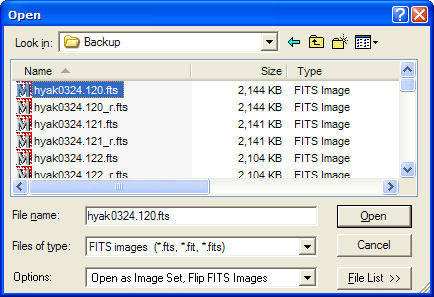
Introduction to Aperture Photometry
This tutorial steps you through making a simple photometric measurement using Mira's Aperture Photometry package. This tutorial assumes you understand how to display an image and do elementary operations like moving the image cursor. To get a quick start on displaying images, see Displaying Your First Image. A separate tutorial describes how to do Time Series Photometry.
To begin, click File > Open on the pull-down menu to open the familiar Open dialog. In the Open dialog, select the image shown below and click [Open].

The image opens as shown below. Before measuring a star, we want to magnify a portion of the field so that it looks like the view shown below (if you need help, see Magnifying the Image).
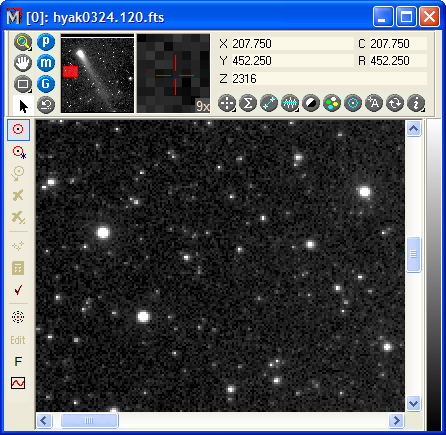
Now click ![]() on the
main toolbar. This displays the Aperture Photometry Toolbar
on the left border of the window (see picture below).
on the
main toolbar. This displays the Aperture Photometry Toolbar
on the left border of the window (see picture below).
In this tutorial, we are measuring a single image, but Mira can measure any number of images displayed as an image set. Before starting photometry, it is important to know that each image contains information needed for calculating magnitudes and their errors (uncertainties). These quantities, stored in the image header, are the exposure time, electronic gain, and readout noise, and they are stored as the keywordsEXPTIME, GAIN, and RDNOISE. If these keywords are not in each image header, or the values are not correct, then you need to add or edit them. Mira provides a way to do this efficiently, even for many images in an image set; see Fixing Header Problems in Photometric Data. You also can have Mira substitute aliases for the standard keywords; see Photometry Keywords.
Now move the mouse pointer to near coordinate (160,458) and click the left mouse button. Mira computes a centroid position near this point and draws a marker on the star near where you clicked:

The magnitude is reported with other information in the Photometric Measurements Report Window shown below. This Report Window lists more than 20 columns of data but we see only the first few (this is configurable). To show more, you can adjust the data table using the scrollbar. See Photometry Measurements to learn more about this report window.

In the Photometric Measurements window shown above, notice
that the magnitude is a large negative number. This results from
the definition of magnitude as -2.5 log (flux) and the fact that a
photometric zero point has not yet been applied (seeAperture Photometry).
We will use a standard star to calculate the zero point. On the
Aperture Photometry Toolbar, click ![]() to enter standard star marking mode,
then click on the standard star. In this case, move the mouse onto
the star near coordinate (57,453) and click to mark the object.
This opens the Standard Data dialog:
to enter standard star marking mode,
then click on the standard star. In this case, move the mouse onto
the star near coordinate (57,453) and click to mark the object.
This opens the Standard Data dialog:
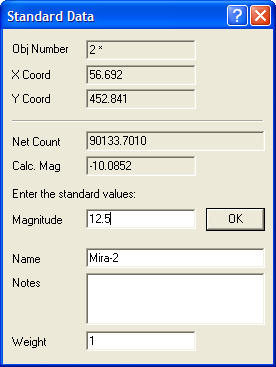
Into the Standard Data dialog, enter the star's magnitude and a statistical weight. You can leave the weight at the default of 1. If you are doing "ensemble photometry", you may wish to use another weight value based on the magnitude or the magnitude uncertainty of the standard star. For the star you just marked, enter 12.5 for the magnitude and click [OK] to accept the value. The image window updates like this:
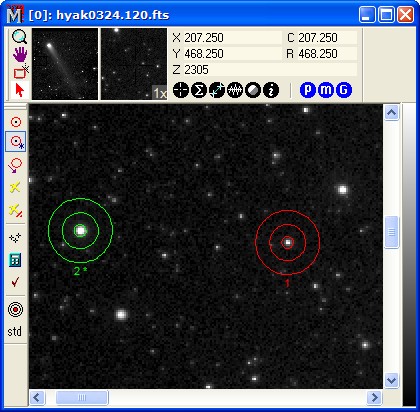
Notice that the standard star has an ID number with
an asterisk (*) beside it; this is used in the photometry report to
show that the measurement was made of a standard star.If the
magnitudes in the table are still negative after marking a standard
star, click ![]() to compute and apply the
photometric zero point. The table now has positive magnitudes.
Notice that the standard star you marked has the magnitude 12.5000
that you entered:
to compute and apply the
photometric zero point. The table now has positive magnitudes.
Notice that the standard star you marked has the magnitude 12.5000
that you entered:

To see more data for these measurements, use the horizontal scrollbar. Two photometric error estimates are listed in the report: Error and Error(T). These are the empirical (measured) uncertainty and the theoretical uncertainty for the calculated magnitude. Mira also saves the photometric zero point and its uncertainty to the image header (see ZERO-PT and ZERPTERR keywords in the table of FITS Keywords), but these values are not saved to files unless you save the images using File > Save or an equivalent command. With the zero point saved in the image header, you can do photometry on another occasion and the magnitude measurements will automatically be convert raw to instrumental values with the zero point applied.
Now let us return to measuring magnitudes. Click
![]() on the toolbar to switch to
Marking
Mode. Click 3 more stars as shown below, and then
switch to Standard mode. Mark object 6 as a second standard star
and enter the value 12.62 for its magnitude, then click
[OK] to close the dialog.
on the toolbar to switch to
Marking
Mode. Click 3 more stars as shown below, and then
switch to Standard mode. Mark object 6 as a second standard star
and enter the value 12.62 for its magnitude, then click
[OK] to close the dialog.
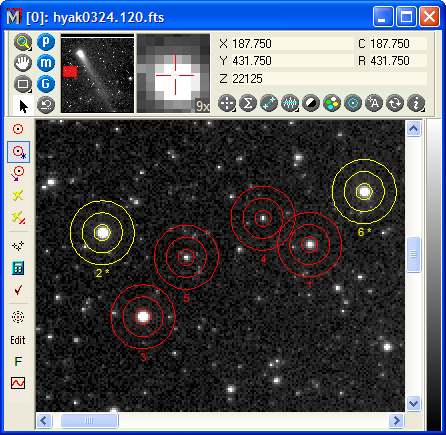
Now click ![]() to recalculate
the zero point using 2 standards. This produces the table below.
Notice that the two standard stars now have magnitudes that are not
the same as the values you entered. This happens because their
magnitudes are calculated using the zero point value. Each standard
star now has a residual, which is the difference between its
calculated magnitude and its predicted magnitude based on the
photometric zero point. The residuals are listed in one of the
columns to the right of the table (you will have to use the
horizontal scrollbar to view it).
to recalculate
the zero point using 2 standards. This produces the table below.
Notice that the two standard stars now have magnitudes that are not
the same as the values you entered. This happens because their
magnitudes are calculated using the zero point value. Each standard
star now has a residual, which is the difference between its
calculated magnitude and its predicted magnitude based on the
photometric zero point. The residuals are listed in one of the
columns to the right of the table (you will have to use the
horizontal scrollbar to view it).

Now that there are 6 measurements in the report table, you may wish to save these results to a file or export them to other software such as Microsoft Excel where you might do further analysis. This simple procedure is described in Exporting Report Data. If you save the coordinates to a file, you can use the Import command on the Points Preferences page to load the object coordinates at a future date.
By now you have doubtless noticed the scrolling text editor named Photometry Messages. This window lists results of photometry calculations and gives warning messages. The contents of the message window can be edited, printed, copied, or saved to a file.

Suppose we did not like the aperture sizes and
shapes that were used for these measurements. These can be changed
using the Aperture Tool
Window. To open the Aperture Tool, click ![]() on the Aperture Photometry Toolbar. This tool
window is a shared resource used by whichever photometry window is
currently active). When you change the aperture description, Mira
automatically re-measures and updates the report table.
on the Aperture Photometry Toolbar. This tool
window is a shared resource used by whichever photometry window is
currently active). When you change the aperture description, Mira
automatically re-measures and updates the report table.
Mira can also perform other useful operations like the following:
If measuring an image set, Plot a Light Curve.
Prepare a report for the AAVSO.
Use multiple standards to do "emsemble photometry".
Use elliptical apertures.
Copy and paste object markers from an image window with active Aperture Photometry window to another image window.
Perform "series photometry" by tracking, measuring, and calibrating objects through an image set.
Import data from a catalog database by (column,row) or (RA, Dec). The objects can be tracked to other images, measured, and calibrated for the entire image set.
Getting Started, Aperture Photometry, Tutorial: Doing Time Series Photometry, Plot Light Curve, Prepare AAVSO Report, Fixing Header Problems in Photometric Data, FITS Format